April 29, 2013
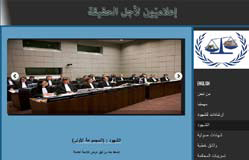 |
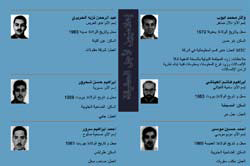 |
| A screenshot of the 'Truth-Up' website's homepage and a sample of the details it published about the witnesses. |
On April 11, al-Akhbar echoed the information when it published an article (which can only be described as a frontal attack) that condemned the “corrupt” STL. Titled "The International Tribunal is Reeling," it introduced the new website, which was launched by a group known as "Journalists for the Truth." In an effort to demonstrate the close synchronization between al-Akhbar (among other outlets) and the obscure website, and to ensure the identity of the individuals in question was made perfectly clear, the newspaper took the extraordinary step of listing the witnesses' place and year of birth, current residence, career and even the names of their mothers. Interestingly, the newspaper published the list a day after the website operated by al-Mustaqbal newspaper (backed by the Future Movement) was hacked and used to leak the names of the witnesses. Some 167 names appeared on the website, in Arabic and English, along with the claim that “the information about the witnesses was leaked by the tribunal.” The homepage of that Hariri-backed newspaper also urged readers to visit the newly launched site.
 |
| One of the interior pages of the April 10, 2013 issue of al-Akhbar discloses the details published about the witnesses. |
.jpg) |
| A quick review of the navigation bar on the al-Manar TV homepage onveys an immediate understanding of the gravity Hezbollah and its media outlets ascribe to the STL issue |
 |
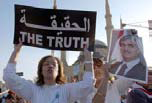 |
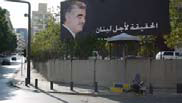 |
 |
In 2005, every conceivable medium was used to demand "the truth." Here, pins, banners, placards and even the pedestal of the martyr's statue--which became an improvised billboard--were pressed into service to advance the claim "We want the truth!"
The STL is responsible for investigating one of the most politically (and confessionally) charged events to have occurred in a country where even the choice of coffeehouse is a political statement. Once known as “Mr. Lebanon,” former Prime Minister Rafik Hariri was killed February 14, 2005 by a massive car bomb. The tremendous force of the blast not only left a gaping crater in the road outside the legendary St. Georges Hotel, but it also drove the Lebanese to launch their “Beirut Spring,” a movement aimed not only at protesting Hariri's assassination and ousting the Syrian army from Lebanon, but also at rejuvenating Lebanon's political system and arena. The day after the assassination, throngs of people began demanding their right to learn “the truth” about Hariri's death as they escorted him to his final resting place. The pivotal act of having to bury yet another victim once seemed as though it had jarred the Lebanese awake from their collective stupor. Somehow, it helped them recognize that the two-pronged ideology behind amnesty and amnesia (which evolved following the Taif Agreement into some sacred creed) did little more than force the country into an inescapable deadlock. Clearly, that transformation is worthy of investigation. In fact, February 15, 2005 was the day the word truth was finally included in the lexicon of Lebanese politics. Although the country was divided into two large camps named in recognition of significant dates (March 8 and March 14), the Lebanese who decided to support the truth not only wanted the truth about Hariri’s assassination, but they also advocated farreaching political reforms that would undermine the very pillars of the Lebanese system. Thus, it is perhaps no coincidence that the website launched recently—and briefly—to undercut the STL's investigation was named “truth-up.”
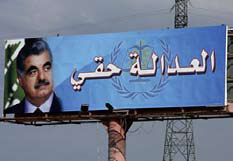 |
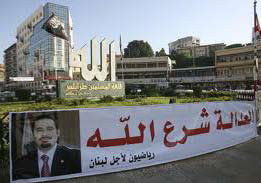 |
| At certain times, the concept behind “Justice” was as fashionable as that behind “Truth.” On the left, a he billboard emblazoned with a portrait of the late prime minister and the STL logo reads, “Justice is my Right.” The banner to the right, hung on the fence that borders Tripoli’s main traffic roundabout, featured a picture of Saad Hariri and was signed by an obscure group called “Sportsmen for Lebanon.” It reads, “Justice is God’s Commandment.” |
Having been tasked with investigating the truth behind the country’s most infamous assassination, the tribunal itself has long since been an arbiter of controversy. Initial investigations originally pointed the finger of guilt at Syria, itself a controversial act that involved the scandalous "false witnesses" issue and an accusation by Jamil as-Sayyed (the former head of General Security) that former Prime Minister Saad Hariri (the son of the late former prime minister), paid the witnesses to accuse the Syrian authority. Indeed, the younger Hariri remained particularly outspoken in his indictment of Syria until 2009. Syria and Saudi Arabia have often been charged with using Lebanon as a battleground on which to seek the expansion of their respective regional influence, but following an official rapprochement between the two countries, Saad Hariri made a personal visit to Syrian President Bashar al-Assad in Damascus. That same year, a Syrian Embassy was established in Lebanon. Taken together, these actions elucidated the choice made by the prime minister “between competing priorities that [became] increasingly impossible to pursue simultaneously: the drive to find his father’s killers and the need to govern Lebanon.” Thus, the STL’s biggest Lebanese advocate effectively abandoned it by trading lubricating a short-lived Syrian-Saudi political deal with the blood of his father.
In May 2009, the German newspaper Der Spiegel published an article which claimed that Hezbollah would be implicated in the assassination, thereby diverting blame from Syria to its local proxy organization. Following that article, there were clear indications that the court was redirecting its focus after a crowd of women verbally assaulted two STL investigators and a translator, all of whom had traveled to Dahiyeh to question Dr. Iman Charara. The women surrounded the investigators and screamed accusations that they were “American” or “Israeli.” The Der Spiegel article, which caused considerable commotion, proved somewhat accurate when four Hezbollah members were indeed indicted in January 2011 for their involvement in the assassination. Hezbollah leader Sayyed Hassan Nasrallah famously threatened to “cut off the hand” of anyone who attempted to arrest the Hezbollah members in question. The individuals remain protected and are being tried in absentia.
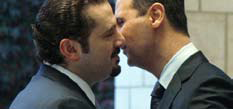 |
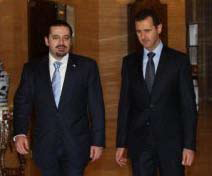 |
| During Saad Hariri's unique premiership, which ran from November 9, 2009 to June 13, 2011, a Saudi-Syrian rapprochement took place following Hezbollah's Beirut blitz (May 2008) and the Doha agreement. As Prime Minister, Hariri visited Damascus twice, in December 2009 and May 2010. |
Al-Akhbar, like any other media outlet, publishes what it considers appropriate in accordance with its editorial line, and does not evade its responsibilities toward all concerned…it will treat all matters of “public right” as being part of what the public is entitled to know.
Al-Amin also tried to avoid blame by stating that al-Akhbar was “not the first media outlet to attempt to release the names of witnesses and other issues linked to the tribunal….”
Since the STL's indictment of the Hezbollah members, the court seems to have entered a slow, downward spiral in terms of its effectiveness. A change of prosecutors, budget woes and increasing criticism for its lack of progress have exacerbated the public's already skeptical opinion of the court. Lebanese support for the trial has waned slowly but steadily, due in part to the failure of the "Beirut Spring" to foment any tangible political change. Many Lebanese were originally in favor of a trial as a means to avenge the blood Hariri spilled, but it has become quite apparent that most Lebanese misunderstood the precedent such a trial might set, especially since it could end the “culture of impunity” that has long since influenced Lebanon’s history. Moreover, the STL would be plagued by bureaucratic red tape and an exceptionally long wait for action. It should come as no surprise, however, that the Lebanese were unable to interpret the trial for its intended purpose, particularly since no other means of achieving any kind of transitional justice has been utilized in the country despite its many wars. The STL has essentially become a political orphan, as few Lebanese are concerned about the trial and even fewer actually support it. Ultimately, the almost complete lack of response to this most recent scandal helps to underscore the tribunal’s imminent death.
With the publication of these witness lists, however, the real culprits have likely browbeaten any Lebanese citizen sufficiently—to include those who were named, those who were named "accidentally" and those who remain unidentified— to prevent them from cooperating with the court. Already without the means to arrest and try those truly responsible for Hariri's assassination, the court may even have lost its ability to offer symbolic justice, and therefore provide any sense of closure either to the Hariri family or to the constituency of the Future Movement. In sum, Hezbollah has deftly subverted the STL without suffering any self-incrimination. By employing third-party resources such as its media arms and the "witness" website, it has indeed swept the Hariri issue aside—an outcome typical for Lebanon’s many assassinations. At this point, we can likely expect the STL to give one final bow before it joins Hariri in becoming yet another memory of Lebanon’s tumultuous past.
Since the STL's indictment of the Hezbollah members, the court seems to have entered a slow, downward spiral in terms of its effectiveness. A change of prosecutors, budget woes and increasing criticism for its lack of progress have exacerbated the public's already skeptical opinion of the court. Lebanese support for the trial has waned slowly but steadily, due in part to the failure of the "Beirut Spring" to foment any tangible political change. Many Lebanese were originally in favor of a trial as a means to avenge the blood Hariri spilled, but it has become quite apparent that most Lebanese misunderstood the precedent such a trial might set, especially since it could end the “culture of impunity” that has long since influenced Lebanon’s history. Moreover, the STL would be plagued by bureaucratic red tape and an exceptionally long wait for action. It should come as no surprise, however, that the Lebanese were unable to interpret the trial for its intended purpose, particularly since no other means of achieving any kind of transitional justice has been utilized in the country despite its many wars. The STL has essentially become a political orphan, as few Lebanese are concerned about the trial and even fewer actually support it. Ultimately, the almost complete lack of response to this most recent scandal helps to underscore the tribunal’s imminent death.
With the publication of these witness lists, however, the real culprits have likely browbeaten any Lebanese citizen sufficiently—to include those who were named, those who were named "accidentally" and those who remain unidentified— to prevent them from cooperating with the court. Already without the means to arrest and try those truly responsible for Hariri's assassination, the court may even have lost its ability to offer symbolic justice, and therefore provide any sense of closure either to the Hariri family or to the constituency of the Future Movement. In sum, Hezbollah has deftly subverted the STL without suffering any self-incrimination. By employing third-party resources such as its media arms and the "witness" website, it has indeed swept the Hariri issue aside—an outcome typical for Lebanon’s many assassinations. At this point, we can likely expect the STL to give one final bow before it joins Hariri in becoming yet another memory of Lebanon’s tumultuous past.
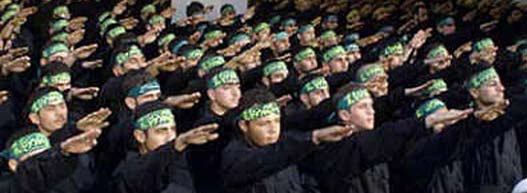
The use of the media to intimidate Lebanese citizens, such as the incident that occurred at the medical clinic of Dr. Iman Sharara, is certainly not the only tactic Hezbollah has used to disrupt the course of the STL. When the initial indictments and supporting materials were submitted to the STL's pre-trial judge on January 17, 2011, the documents certainly should have remained confidential. Yet leaks disclosed that the indictment focused on Hezbollah members. The next day, Hezbollah staged a show of force that involved dozens of militants. Ostensibly unarmed, scores of blackshirted men were deployed to several of Beirut’s most strategic areas. Although the “exercise” lasted only a few hours, it certainly conveyed the intended message. Known as the “day of the black shirts,” the January 18, 2011 event became the Lebanese prototype for paramilitary action that clearly threatens violence but spills no blood.
-------------------------------------------------------
Kelly Stedem contributed to this article
-------------------------------------------------------
Kelly Stedem contributed to this article
-------------------------------------------------------

 Print
Print Share
Share